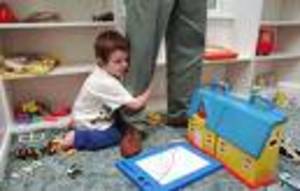Parents and grandparents of children with an autism spectrum disorder are continually seeking new ways for their children to learn. For ‘typical’ children, many forms of learning environments are available, but autism spectrum children have’ fallen through the cracks’ in many cases. Applied Behavior Analysis (ABA) is a proven approach to effective learning for children and young adults with autism spectrum disorders.
This past month, a bill was passed that requires insurances companies to pay for conditions related to autism. Even though ABA therapy is widely prescribed by physicians, the majority of insurance companies have notoriously refused to pay for this valuable learning experience. I hope that this article will explain a bit about Applied Behavior Analysis.
‘Typically Developing’ Children vs. Autism Spectrum Children
‘Typically developing’ children learn without our intervention. The ‘typical’ environment they are born into provides the right conditions to learn language, play and social skills. Children with an autism spectrum disorder/PDD learn much, much less from the environment. These children are often capable of learning, but it takes a very structured environment, one where conditions are optimized for acquiring the same skills that typical children learn ‘naturally.’ Applied Behavior Analysis (ABA) is about the rules for setting up an environment to enable these children to learn.
Understanding Applied Behavior Analysis
Behavior analysis is a natural science approach to understanding behavior. ABA is the use of methods and research findings to change socially important behaviors in meaningful ways. Since the early 1960’s, hundreds of researchers have documented the effectiveness of ABA methods and principals for building a wide range of important skills and reducing problem behaviors in individuals of all ages with autism and other related disorders. Behavioral learning is not the only type of learning. Most learning in schools is from an explanation or by example – what people call ‘natural’ learning. ‘Typically developing’ children learn from their environment (the people around them) at an astounding rate, completely unassisted. Children with an autism spectrum disorder cannot do this.
True ABA programs for learners with autism spectrum disorders often combine many research-validated methods into a highly individualized package. An initial assessment is done to determine skill level or skills that the learner does or does not have. Selection of treatment goals for each individual is guided by data from that initial assessment. The overall goal is to help each learner develop skills that will enable him or her to be as independent and successful as possible in the long run.
The basic principles of Applied Behavior Analysis have been around for quite some time. They have many uses besides the teaching of children with autism. ABA can also be used to address a broad spectrum of human behaviors, such as increasing workplace productivity, to training military personnel, to, of course, teaching children. There are many ABA-based programs and each use their own system of instruction, but each must be based on the principles of ABA. These are:
• The program must be applied. The behaviors that one chooses to focus upon should have some social significance.
• The program must be behavioral. The environment and physical events should be recorded with precision.
• The program must be analytic. There should be clear and convincing evidence, through carefully collected data, that the intervention is responsible for a change in a behavior.
• The program must be technological. The techniques that one uses should be described completely enough to allow for duplication by another individual.
• The program must be conceptually systematic. There should be relevance to established and accepted principles (for example, the principle of operant conditioning).
• The program must be effective. The program should seek to change the targeted behavior to a meaningful degree.
• The program should display some generality. A change in behavior should be seen in a wide variety of environments, or should spread to a wide variety of related or similar behaviors.
ABA is not just for bad behavioral problems, ABA provides the best methods for managing problem and aberrant behavior such as self-injurious, ritualistic, repetitive, aggressive and disruptive behavior, it does this through teaching alternative pro-social behavior. Proper application of behavior principles and procedures also prevents behavior from becoming a problem.
ABA is not a ‘miracle cure’. There are no cures-medical or psychological for autism spectrum/PDD disorders. ABA is not easy, but when it is done properly, progress is seen very quickly. The positive results seen with this program make the effort worthwhile.




